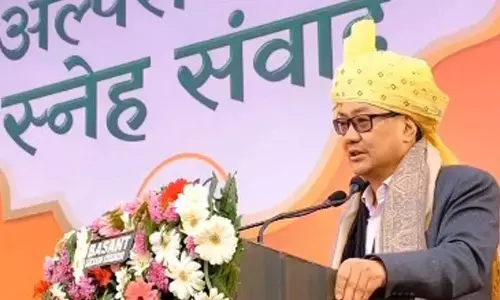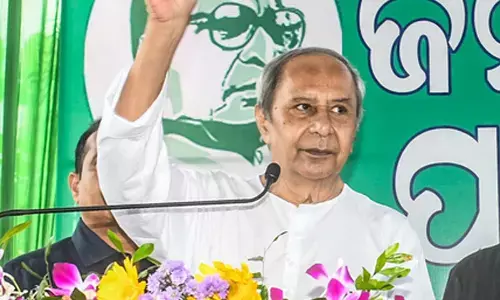Understanding the National Health Policy 2017

Health is one of basic need of any emerging nation. Especially basic and fundamental health care is a determinant in a nation’s growth and progress. It is in this background that a policy document is necessary to guide resource mobilization, allocation and prioritization.
Health is one of basic need of any emerging nation. Especially basic and fundamental health care is a determinant in a nation’s growth and progress. It is in this background that a policy document is necessary to guide resource mobilization, allocation and prioritization.
Background
The National Health Policy, 2017 adopted an elaborate procedure for its formulation involving stakeholder consultations. Accordingly, the Government of India formulated the Draft National Health Policy and placed it in public domain on 30thDecember, 2014. Thereafter following detailed consultations with the stakeholders and State Governments, based on the suggestions received, the Draft National Health Policy was further fine-tuned. It received the endorsement of the Central Council for Health & Family Welfare, the apex policy making body, in its Twelfth Conference held on 27th February, 2016.
The last health policy was formulated in 2002. The socio economic and epidemiological changes since then necessitated the formulation of a New National Health Policy to address the current and emerging challenges.
It is 15 years since we had a National Health Policy (NHP) modified. The last policy was formulated in 2002. Now the Cabinet has cleared the latest NHP 2017 to address the address current and emerging challenges rising from changing socio-economic and epidemiological environments.
Expected Questions
- Is the National Health Policy 2017 is a step in the right direction.
- Discuss the policy critically in view of the rural health parameters of India and global SDGs.
- The latest National Health policy has more misses than hits. What are the lacunae in the policy?
- Enumerate important features of the National Health Policy 2017.
General Studies 2
- Issues relating to development and management of Social Sector/Services relating to Health
- Development processes and the development industry the role of NGOs, SHGs, various groups and associations, donors, charities, institutional and other stakeholders.
Introduction
The Policy seeks to reach everyone in a comprehensive integrated way to move towards wellness. It aims at achieving universal health coverage and delivering quality health care services to all at affordable cost.
This Policy looks at problems and solutions holistically with private sector as strategic partners. It seeks to promote quality of care, focus is on emerging diseases and investment in promotive and preventive healthcare. The policy is patient centric and quality driven. It addresses health security and make in India for drugs and devices.
The main objective of the National Health Policy 2017 is to achieve the highest possible level of good health and well-being, through a preventive and promotive health care orientation in all developmental policies, and to achieve universal access to good quality health care services without anyone having to face financial hardship as a consequence.
In order to provide access and financial protection at secondary and tertiary care levels, the policy proposes free drugs, free diagnostics and free emergency care services in all public hospitals.
The policy proposes raising public health expenditure to 2.5% of the GDP in a time bound manner. Policy envisages providing larger package of assured comprehensive primary health care through the Health and Wellness Centers'.
The policy advocates extensive deployment of digital tools for improving the efficiency and outcome of the healthcare system and proposes establishment of National Digital Health Authority (NDHA) to regulate, develop and deploy digital health across the continuum of care.
Government of India formulated the Draft National Health Policy and placed it in public domain on 30th December, 2014. Thereafter following detailed consultations with the stakeholders and State Governments, based on the suggestions received, the Draft National Health Policy was further fine-tuned. It received the endorsement of the Central Council for Health & Family Welfare, the apex policy making body, in its Twelfth Conference held on 27th February, 2016.
Major features of the policy that aims to transform healthcare in India:
- The policy aims for attainment of highest possible level of health and well-being for every citizen through a preventive and promotive healthcare orientation.
- It seeks to provide and deliver healthcare services, particularly to underprivileged and socially vulnerable groups of people in the country.
- Under the policy, every family will have a health card for access to primary care facility as well as to defined package of services nationwide.
- Health and hygiene to become part of school curriculum – Yoga would be introduced much more widely in schools and work places as part of promotion of good health.
- The policy envisages a three dimensional integration of AYUSH systems by promoting cross referrals, co-location and integrative practices across systems of medicines.
- The policy also seeks to address health security and promotes Make in India for drugs and devices.
- It seeks to establish a Public Health Management Cadre (PHMC) in all states.
- It also proposes rising public health expenditure to 2.5% of the GDP in a time bound manner.
- The government aims in shifting focus from “sick-care” to “wellness”, by promoting prevention and well-being.
- It intends on gradually increasing public health expenditure to 2.5% of the GDP.
- To strengthen health systems by ensuring everyone has
- Access to quality services and technology despite financial barriers. The policy proposes increasing access,
- improving quality and reducing costs. It proposes free drugs, free diagnostics and free emergency and essential healthcare services in public hospitals.
- To focus on primary health care: The policy advocates allocating two-thirds (or more) of resources to primary care. It proposes two beds per 1,000 of the population to enable access within the golden hour (the first 60 minutes after a traumatic injury).
- To reduce morbidity and preventable mortality of non-communicable diseases (NCDs) by advocating pre-screening.
- To promote Prime Minister Narendra Modi ’s ‘Make in India’ initiative by using drugs and devices manufactured in the country.
- It highlights AYUSH (Ayurveda, Yoga & Naturopathy, Unani, Siddha and Homeopathy) as a tool for effective prevention and therapy that is safe and cost-effective. It proposes introducing Yoga in more schools and offices to promote good health.
- Reforming medical education.
- The policy also lists quantitative targets regarding life expectancy, mortality and reduction of disease prevalence in line with the objectives of the policy.
Issues
The National Health Policy 2017, which the Centre announced this week after a nudge from the Supreme Court last year, faces the challenging task of ensuring affordable, quality medical care to every citizen.
- With a fifth of the world’s disease burden, a growing incidence of non-communicable diseases such as diabetes, and poor financial arrangements to pay for care, India brings up the rear among the BRICS countries in health sector performance.
- Against such a laggard record, the policy now offers an opportunity to systematically rectify well-known deficiencies through a stronger National Health Mission.
- Among the most glaring lacunae is the lack of capacity to use higher levels of public funding for health.
- Rectifying this in partnership with the States is crucial if the Central government is to make the best use of the targeted government spending of 5% of GDP by 2025, up from 1.15% now.
- Although a major capacity expansion to produce MBBS graduates took place between 2009 and 2015, and more initiatives were announced later, this is unlikely to meet policy goals since only 11.3% of registered allopathic doctors were working in the public sector as of 2014, and even among these, the number in rural areas was abysmally low.
- More health professionals need to be deployed for primary care in rural areas.
- Availability of trained doctors and nurses would help meet the new infant mortality and maternal mortality goals, and build on the gains from higher institutional deliveries, which exceeded 80% in recent years.
Health care sector specific issues
- Contracting of health services from the private sector may be inevitable in the short term, given that about 70% of all outpatient care and 60% of inpatient treatments are provided by it.
- But this requires accountability, both on the quality and cost of care.
- No more time should be lost in forming regulatory and accreditation agencies for healthcare providers at the national and State levels as suggested by the expert group on universal health coverage of the Planning Commission more than five years ago.
- Without such oversight, unethical commercial entities would have easy backdoor access to public funds in the form of state-backed insurance.
- It should also be mandatory for all health institutions to be accredited, and to publish the approved cost of treatments, in order to remove the prevailing asymmetry of information.
- For the new policy to start on a firm footing, the Centre has to get robust health data.
- Currently this is fragmented because inputs from multiple sources and sample surveys are not reconciled, and the private sector is often not in the picture.
- To reduce high out-of-pocket spending, early deadlines should be set for public institutions to offer essential medicines and diagnostic tests free to everyone.
- This was estimated in 2011 to require a spending increase of only 0.4% of GDP, which is within the 2.5% that the Centre is talking about.
Targets set under the NHP 2017
- Increasing life expectancy to 70 years from 67.5
- Reduce fertility rate to 2.1 (Replacement levels) by 2025.
- Reduce infant mortality rate to 28 by 2019.
- Reduce Under Five Mortality to 23 by 2025.
- Reducing premature mortality from cardiovascular diseases, cancer, diabetes or chronic respiratory diseases by 25% by 2025
- The policy seeks to achieve ‘90:90:90’ global target by 2020 – implying that 90% of all people living with HIV know their HIV status, 90% of those diagnosed with HIV infection receive sustained antiretroviral therapy and 90% of those receiving antiretroviral therapy will have viral suppression.
- Reducing the prevalence of blindness to 0.25 per 1000 persons by 2025 and
- The disease burden to be reduced by one third from the current levels.
- Elimination of leprosy by 2018, kala-azar by 2017 and lymphatic filariasis in endemic pockets by 2017.
- Increase Life Expectancy at birth from 67.5 to 70 by 2025.
- Reduce infant mortality rate to 28 by 2019.
- Reduce Under Five Mortality to 23 by 2025.
- Achieve the global 2020 HIV target (also termed 90:90:90; 90 per cent of all people living with HIV know their HIV status, 90 per cent of all people diagnosed with HIV infection receive sustained antiretroviral therapy and 90 per cent of all people receiving antiretroviral therapy will have viral suppression)
- To reduce premature mortality from cardiovascular diseases, cancer, diabetes or chronic respiratory diseases by 25 per cent by 2025.
Positives of the Policy
- The broad principles of the policy is centered on Professionalism, Integrity and Ethics, Equity, Affordability, Universality, Patient Centered & Quality of Care, Accountability and pluralism.
- This Policy looks at problems and solutions holistically with private sector as strategic partners
- The Policy advocates a progressively incremental assurance-based approach for GDP allocation increase to 2.5% instead of a hollow rhetoric.
- It envisages providing a larger package of assured comprehensive primary health care through the ‘Health and Wellness Centres’ and denotes an important change from very selective to comprehensive primary health care package which includes care for major NCDs [non-communicable diseases], mental health, geriatric health care, palliative care and rehabilitative care services.
- It aims to ensure availability of 2 beds per 1,000 population distributed in a manner to enable access within golden hour [the first hour after traumatic injury, when the victim is most likely to benefit from emergency treatment].
- In order to provide access and financial protection, it proposes free drugs, free diagnostics and free emergency and essential health care services in all public hospitals
Criticism of the Policy
- The policy duplicates portions of the Health section 2017 Budget speech.
- It reiterates health spend targets set by the High Level Expert Group (HLEG) set up by the erstwhile Planning Commission for the 12th Five Year Plan (which ends on March 31, 2017)
- It also fails to make health a justiciable right through National Health Rights Act like the Right to Education Act 2005 did for school education.
- A health cess was a path-breaking idea in the Health Ministry’s draft policy; it has now been dropped out of the final policy
- The government through 2002 policy promised it would increase health spending to 2 percent of GDP, which never happened either under the National Democratic Alliance (NDA-1) or during 10 years of the United Progressive Alliance (UPA) administration.
- Old Targets and New Deadlines: Look at the Graphic below.
- The IMR in 2015-16 was 41.
- The MMR in 2015-16 is 167.
- The 2002 NHP had set the target of eliminating leprosy by 2005, kala azar by 2010 and lymphatic filariasis by 2015–none of which could be achieved yet.
Conclusion
A policy document is important for any sector to be effectively handled and planned keeping future priorities in mind. Health care has long desired a holistic policy. Though there are lacunae a start in right direction will help correct necessary problems.














